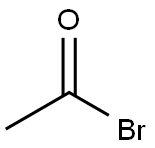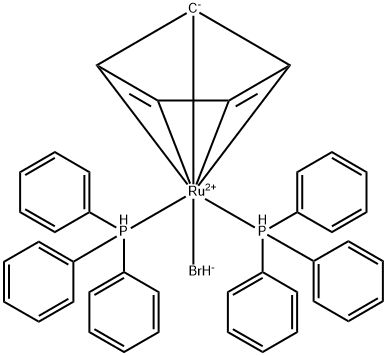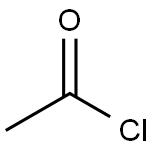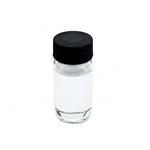Acetyl chloride
- CAS No.
- 75-36-5
- Chemical Name:
- Acetyl chloride
- Synonyms
- AcCl;CH3COCl;ETHANOYL CHLORIDE;ACETYL-TRANS-RESVERATROL;ACETYLCLORIDE;Acetic chloride;Lidocaine Impurity 38;UN1717 (DOT);Acetylchlorid;ACETYL CHLORIDE
- CBNumber:
- CB4485487
- Molecular Formula:
- C2H3ClO
Lewis structure

- Molecular Weight:
- 78.5
- MDL Number:
- MFCD00000719
- MOL File:
- 75-36-5.mol
- MSDS File:
- SDS
| Melting point | -112 °C |
|---|---|
| Boiling point | 52 °C(lit.) |
| Density | 1.104 g/mL at 25 °C(lit.) |
| vapor density | 2.7 (vs air) |
| vapor pressure | 11.69 psi ( 20 °C) |
| refractive index |
n |
| Flash point | 40 °F |
| storage temp. | Store below +15°C. |
| solubility | Miscible with acetone, chloroform, glacial acetic acid, petroleum ether, ether and benzene. |
| form | Liquid |
| Specific Gravity | approximate 1.11 |
| color | Clear colorless |
| Odor | Strong pungent odor |
| explosive limit | 7.3-19%(V) |
| Water Solubility | Decomposes violently in water |
| Sensitive | Moisture Sensitive |
| Merck | 14,85 |
| BRN | 605303 |
| Dielectric constant | 16.9(2℃) |
| Stability | Stability Highly flammable. Reacts violently with DMSO, water, lower alcohols, and amines to generate toxic fumes. May form an explosive mixture with air. Note low flash point. Incompatible with water, alcohols, amines, strong bases, strong oxidizing agents, most common metals. |
| InChIKey | WETWJCDKMRHUPV-UHFFFAOYSA-N |
| CAS DataBase Reference | 75-36-5(CAS DataBase Reference) |
| EWG's Food Scores | 1 |
| FDA UNII | QD15RNO45K |
| NIST Chemistry Reference | Acetyl chloride(75-36-5) |
| EPA Substance Registry System | Acetyl chloride (75-36-5) |
SAFETY
Risk and Safety Statements
| Symbol(GHS) |   GHS02,GHS05 |
|||||||||
|---|---|---|---|---|---|---|---|---|---|---|
| Signal word | Danger | |||||||||
| Hazard statements | H225-H314 | |||||||||
| Precautionary statements | P210-P233-P240-P280-P303+P361+P353-P305+P351+P338 | |||||||||
| Hazard Codes | F,C,Xn | |||||||||
| Risk Statements | 11-14-34-40-36/38 | |||||||||
| Safety Statements | 9-16-26-45-1/2-36/37 | |||||||||
| RIDADR | UN 1717 3/PG 2 | |||||||||
| WGK Germany | 1 | |||||||||
| RTECS | AO6390000 | |||||||||
| F | 3 | |||||||||
| Autoignition Temperature | 390 °C DIN 51794 | |||||||||
| TSCA | Yes | |||||||||
| HazardClass | 3 | |||||||||
| PackingGroup | II | |||||||||
| HS Code | 29159080 | |||||||||
| NFPA 704 |
|
Acetyl chloride price More Price(35)
| Manufacturer | Product number | Product description | CAS number | Packaging | Price | Updated | Buy |
|---|---|---|---|---|---|---|---|
| Sigma-Aldrich | 8.22252 | Acetyl chloride for synthesis | 75-36-5 | 100mL | $50.2 | 2024-03-01 | Buy |
| Sigma-Aldrich | 8.22252 | Acetyl chloride for synthesis | 75-36-5 | 1L | $115 | 2024-03-01 | Buy |
| Sigma-Aldrich | 00990 | Acetyl chloride puriss. p.a., ≥99.0% (T) | 75-36-5 | 100ml | $54.1 | 2024-03-01 | Buy |
| Sigma-Aldrich | 00990 | Acetyl chloride puriss. p.a., ≥99.0% (T) | 75-36-5 | 1l | $219 | 2024-03-01 | Buy |
| TCI Chemical | A0082 | Acetyl Chloride >98.0%(GC)(T) | 75-36-5 | 100g | $44 | 2024-03-01 | Buy |
Acetyl chloride Chemical Properties,Uses,Production
Uses
Acetyl Chloride is a very useful synthetic intermediate. It is a derivative of acetic acid, a weak acid, used as a reagent in numerous industrial processes. It is a chemical for acetylation in the synthesis or derivatization of organic compounds.
Physical and chemical properties
It appears as colorless fuming liquid with a strong odor and eye irritation effect. The relative density of 1.1051 (20 ° C), the melting point of-112 ° C, the boiling point of 51-52 ° C and the flash point is 4.4 ° C (closed dish). In the wet air, it can slowly undergo decomposition and give white smoke. When coming across water, it can be violently hydrolyzed into acetic acid and hydrogen chloride, and thus should be sealed for storage. It is miscible with benzene, acetone, chloroform, ether, glacial acetic acid and petroleum ether. Liquid is heavier than water with the vapor being heavier than air. Its chemical nature is lively. It can have metathesis reaction with many compounds. Acetyl chloride can bind to the thiol group in the protein, and therefore being toxic to humans. It is an important kind of acetylation agents with its acylation capability being stronger than acetic anhydride. It is widely used in organic synthesis, being also the catalyst for the chlorination of carboxylic acids. It is manufactured through the mixing of glacial acetic acid and phosphorus trichloride in cold condition with further heating, followed by dehydrochloration distillation.
Dangerous situation
(1) It has corrosive effect against the skin and mucous membranes with strong irritant effect on the eyes.
(2) It is easily flammable with the burning point being 390 ℃ and a greater risk of combustion. Its vapor can form an explosive mixture with air with the explosion limit remaining not be determined. Since the vapor is heavier than air, it can spread to a considerable distance and cause ignition of a source of fire and further propagate the flame back. It can have violent reaction when coming across water and alcohol. When being heated to decomposition, it can release HCl and highly toxic phosgene gas.
The main purpose
Acetyl chloride is the most commonly used acetylating agent with reaction with alcohol and phenol generating acetate ether. Its reaction with ammonia can generate acetamide with its interaction with primary amine and secondary amine to generate N-substituted acetamide.
It can be used for the manufacturing of pharmaceutical industry, pesticide manufacturing, acetyl derivatives and dyes. It can be used as the reagents for the determination of phosphorus, cholesterol, water content contained in organic solvents, nitroso, hydroxyl and tetraethyl lead.
Acetyl chloride is the most important acyl halide and can be manufactured through the reaction between glacial acetic acid and thionyl chloride or phosphorus trichloride and phosphorus pentachloride.
The above information is edited by Andy from ChemicalBook.
Harmful effects and symptoms of poisoning
Acetyl chloride is a kind of stimulant and corrosive with contact with the skin being able to cause burns. Its steam can strongly irritate the eye and mucous membranes. Human’s inhalation of 2 ppm will be able to feel stimulating effect. Short-term exposure to higher concentrations of acetyl chloride may cause death or permanent damage. The poisoning amount of the aquatic animal is estimated to be in the range of 10 to 100 ppm.
Chemical properties
It appears as colorless transparent liquid smoke with irritating smell. It is miscible with ether, acetic acid and benzene.
Uses
1. It is a kind of acetylating agent, being used as raw materials for pesticides and medicine, or the intermediates for the manufacturing of water treatment agent ethylidene diphosphate.
2. It can be used for the analysis of reagents as well as used for the preparation of acetyl derivatives and dyes
3. It can be used for organic synthesis, dyes and pharmaceutical industries
4. It can be used as the raw materials of pesticides and pharmaceutical as well as the intermediate for the manufacture of water treatment agent ethylene diphosphate. Moreover, it can also be used for the manufacture of new electroplating complexing agent. Acetyl chloride is an important acetylating agent with the acylation capability being stronger than acetic anhydride. It is widely used in organic synthesis and dyes. It is also the catalyst for the carboxylic acid to have chlorination reaction as well as being used for hydroxyl and amino quantitative analysis.
5. This product can be used as raw material for organic synthesis, used in the production of pesticides, pharmaceuticals, new electroplating complexing agent, the catalyst for carboxylic acid to have chlorination, acetylation agent, and other kinds of fine organic synthesis intermediates.
Production method
Industrial, acetyl chloride can be manufactured through the reaction between ethylene with hydrogen chloride, or the reaction between sodium acetate, sulfur dioxide and chlorine. The laboratory can apply acetic acid, sodium acetate or acetic anhydride to have reaction with a variety of chlorination agents. For example, it can be obtained through the reaction between acetic anhydride with chlorosulfonic acid (or hydrogen chloride, carbon tetrachloride, phosgene); or obtained through the reaction between glacial acetic acid and benzoyl chloride (or silicon tetrachloride, phosphorus trichloride, chlorinated sulfurous acid and phosphorus pentachloride,). OPERATION EXAMPLE 1: Ingredient ratio (molar ratio): glacial acetic acid: phosphorus trichloride = 3: 1.2. Glacial acetic acid was added to the reactor and stirred slowly. Phosphorus trichloride was added drop-wise over 10-15 min at room temperature. The reaction mixture is subjecting to heating to increase reaction temperature and subject to reaction being maintained at 40-50 °C for 0.5 h. The reaction product is static with the separation obtaining crude product of acetyl chloride and the yield of about 70%.
Operation Example 2 Into a 3 L three-necked flask, add 360 g (6 mol) of glacial acetic acid and 552 g of toluene; heat to 50 °C, and add dropwise 510 g (3 mol) of silicon tetrachloride over 30 min. Keep the temperature at 50 ° C to until hydrogen chloride gas stops being released. Then apply fractionation, steam to until the temperature of the top of the column reaches 80-85 ℃ to obtain the crude product. The fine product is further subject to re-distillation. Take the 50-65 °C fractions and obtain 400 g of acetyl chloride with the yield being 85%. Fixed consumption amount of raw materials: glacial acetic acid: 850kg/t, phosphorus trichloride: 1950kg/t.
Hazards & Safety Information
Category Flammable liquids
Toxic grading poisoning
Acute Toxicity Oral-Rat LD50: 910 mg/kg
Dangerous properties of explosives being corrosive to the skin, eyes and mucous membrane;
Flammable and hazardous properties it is flammable in case of fire, high temperature and oxidant; at high temperature, it can be subject to decomposition to release toxic phosgene; it can release toxic chloride when coming across water;
Storage and transportation characteristics Treasury: ventilation, low-temperature and drying; store separately from oxidants and acids;
Extinguishing agent dry powder, dry sand, dry stone powder, carbon dioxide, foam
Description
Acetic chloride is a colourless to light yellow liquid with a pungent and choking odour. Acetic chloride is highly flammable and reacts violently with DMSO, water, lower alcohols, and amines to generate toxic fumes. Along with air, acetic chloride may form an explosive mixture. It is incompatible with water, alcohols, amines, strong bases, strong oxidising agents, and most common metals. On decomposition when heated, acetic chloride produces carbon monoxide, carbon dioxide, hydrogen chloride, and phosgene.
Chemical Properties
Acetyl chloride is a highly flammable, colorless, fuming liquid with a pungent odor
Chemical Properties
colourless to light yellow liquid with a pungent
Chemical Properties
Acetic chloride is a colorless to light yellow liquid with a pungent and choking odor. Acetic chloride is highly flammable, reacts violently with dimethyl sulfoxide (DMSO), water, lower alcohols, and amines to generate toxic fumes. Together with air, acetic chloride may form an explosive mixture. It is incompatible with water, alcohols, amines, strong bases, strong oxidizing agents, and most common metals. On decomposition when heated, acetic chloride produces carbon monoxide, carbon dioxide, hydrogen chloride, and phosgene.
Uses
Acetyl chloride acts as a reagent for the preparation of esters and amides of acetic acid. It is also useful an important reactant in Friedel-Crafts reactions as well as the introduction of an acetyl group. It serves as a starting material in the production of pharmaceutical, new plating complexing agent, acylation agent and synthetic organic intermediates.
Uses
Acetyl chloride can be used as:
- A degradation agent in the degradation of polyoxyethylene glycol monoalkyl ethers to determine the degree of ethoxylation using chromatography-mass spectrometry (MS).
- A reagent with alcohols for the esterification of carboxylic acids, N-boc deprotection, and phosphoramide solvolysis reactions.
Uses
Acetylating agent; in testing for cholesterol, determination of H2O in organic liquids.
Definition
A liquid acyl chloride used as an acetylating agent.
General Description
A colorless, fuming liquid with a pungent odor. Density 9.2 lb / gal. Flash point 40°F. Vapor, which is heavier than air, irritates the eyes and mucous membranes. Corrosive to metals and tissue.
Acetyl chloride, CH30CCI, can be prepared by treatment ofacetic acid with various reagents, such as PCl3 SOCl2 or COCI2. It can be prepared by chlorination of acetic anhydride in several different ways, by reaction of methyl chloride with carbon monoxide in the presence of catalysts, by reaction ofketene with HCI, or by partial hydrolysis of 1, 1, l-trichloroethane, Acetyl chloride hydrolyzes in the presence of water to give acetic acid. It reacts with ammonia and amines to give acetamides. Reaction with alcohols gives the corresponding acetate esters. Acetyl chloride will add across unsaturated bonds in the presence ofsuitable catalysts to give halogenated ketones.
Reactivity Profile
Acetyl chloride reacts violently with water, steam, methanol or ethanol to form hydrogen chloride and acetic acid. Reacts vigorously with bases, both organic and inorganic. Incompatible with oxidizing agents and alcohols. Produces highly toxic fumes of phosgene gas and chlorine when heated to decomposition [Sax, 9th ed., 1996, p. 35]. Reaction in a confined space with even a small amount of water may cause a violent eruption of gases [Bretherick, 5th ed., 1995, p. 281]. Vapor forms an explosive mixture with air [Kirk-Othmer, 3rd ed., Vol. 1, 1978, p. 162]. Polymerization reaction with dimethyl sulfoxide is particularly violent [Buckley, A., J. Chem. Ed., 1965, 42, p. 674]. May react vigorously or explosively if mixed with diisopropyl ether or other ethers in the presence of trace amounts of metal salts [J. Haz. Mat., 1981, 4, 291].
Health Hazard
Vapor irritates mucous membranes. Ingestion of liquid or contact with eyes or skin causes severe irritation.
Health Hazard
Exposure to acetic chloride causes severe health effects. It is corrosive and causes severe skin burns. On contact with the eyes and skin and accidental ingestion, acetic chloride causes permanent eye damage and serious burns to the mouth and stomach. The spray mist or liquid causes tissue damage (mucous membranes of eyes, mouth, and upper respiratory tract). Inhalation of the spray mist causes severe irritation of the respiratory tract, with symptoms of a burning sensation, coughing, wheezing, laryngitis, shortness of breath, headache, nausea, and vomiting. Prolonged periods of inhalation of acetic chloride may be fatal as a result of spasm, infl ammation, and edema of the larynx and bronchi, chemical pneumonitis, and pulmonary edema characterized by coughing, choking, or shortness of breath. However, there is no published information about the carcinogenicity, mutagenicity, teratogenicity, and developmental toxicity of acetic chloride in animals and humans.
Safety Profile
Poison by inhalation. Moderately toxic by ingestion. A human systemic irritant by inhalation. Violent hydrolysis reaction with water or steam produces heat, acetic acid, HCl, and other corrosive chlorides. May decompose during preparation. Dangerous fire hazard when exposed to heat or flame. Explosion hazard by spontaneous chemical reaction with dimethyl sulfoxide or ethanol. Also incompatible with Pcb. When heated to decomposition it emits highly toxic fumes of phosgene and Cl-. To fight fire, use CO2 or dry chemical. See also CHLORIDES
Potential Exposure
Acetyl chloride is used in organic synthesis as an acetylating agent and in testing for water and/ or cholesterol in organic liquids, in the pharmaceutical industry and in pesticide manufacture.
storage
Acetic chloride should be stored in a segregated and approved area, away from incompatibles such as oxidizing agents, alkalis and moisture. The container of acetic chloride should be kept in a cool, well-ventilated area, tightly sealed until ready for use. Users should avoid all possible sources of ignition, i.e., spark or flames.
Shipping
UN1717 Acetyl chloride, Hazard Class: 3; Labels: 3-Flammable liquid, 8-Corrosive material
Purification Methods
Reflux acetyl chloride with PCl5 for several hours to remove traces of acetic acid, then distil it. Redistil it from one-tenth its volume of dimethylaniline or quinoline to remove free HCl. A.R. quality is freed from HCl by pumping it for 1hour at -78o and distilling it into a trap at -196o. [Beilstein 2 IV 395.] LACHRYMATORY.
Incompatibilities
ticide manufacture. Incompatibilities: Avoid contact with moisture, steam, water, alcohols, dimethylsulfoxide, strong bases; phosphorus trichloride; oxidizers, and amines, since violent reactions may occur. Keep away from heat, fire, and welding operations.
Waste Disposal
Consult with environmental regulatory agencies for guidance on acceptable disposal practices. Generators of waste containing this contaminant (≥100 kg/mo) must conform with EPA regulations governing storage, transportation, treatment, and waste disposal. May be mixed slowly with sodium bicarbonate solution and then flushed to sewer with large volumes of water. May also be incinerated.




Acetyl chloride Preparation Products And Raw materials
Raw materials
1of2
Preparation Products
1of8
| Supplier | Tel | Country | ProdList | Advantage | |
|---|---|---|---|---|---|
| Hebei Weibang Biotechnology Co., Ltd | +8615531157085 | abby@weibangbio.com | China | 8812 | 58 |
| Lihe Pharm Technology(Wuhan)Co.,Ltd | +8618071517867 | info@lihepharma.com | China | 192 | 58 |
| Hefei TNJ Chemical Industry Co.,Ltd. | +86-0551-65418684 +8618949823763 | sales@tnjchem.com | China | 25356 | 58 |
| SHANGHAI KEAN TECHNOLOGY CO., LTD. | +8613817748580 | cooperation@kean-chem.com | China | 40066 | 58 |
| Henan Fengda Chemical Co., Ltd | +86-371-86557731 +86-13613820652 | info@fdachem.com | China | 20287 | 58 |
| Capot Chemical Co.,Ltd. | +86-(0)57185586718 +86-13336195806 | sales@capot.com | China | 29791 | 60 |
| Henan Tianfu Chemical Co.,Ltd. | +86-0371-55170693 +86-19937530512 | info@tianfuchem.com | China | 21634 | 55 |
| Hefei TNJ Chemical Industry Co.,Ltd. | +86-0551-65418679 +8618949832763 | info@tnjchem.com | China | 2986 | 55 |
| Shanxi Naipu Import and Export Co.,Ltd | +86-13734021967 +8613734021967 | kaia@neputrading.com | China | 1001 | 58 |
| career henan chemical co | +86-0371-86658258 +8613203830695 | sales@coreychem.com | China | 29884 | 58 |
Related articles
- The uses of Acetyl chloride
- Acetyl chloride is a powerful acetylating agent. It is used in the manufacture of aspirin, acetaminophen, and acetanilide. Liq....
- Apr 24,2024
- Acetyl Chloride: Preparation and Hazards
- The passage introduces the preparation and hazards of Acetyl chloride.
- Nov 22,2022
- Acetyl chloride –Chemical Properties and Application in Reagents
- Acetyl chloride [75-36-5], C2H3OCl, mol wt 78.50, is a colorless, corrosive, irritating liquid that fumes in air. It has a sti....
- Apr 1,2020
View Lastest Price from Acetyl chloride manufacturers
| Image | Update time | Product | Price | Min. Order | Purity | Supply Ability | Manufacturer | |
|---|---|---|---|---|---|---|---|---|
 |
2024-10-28 | Acetyl chloride
75-36-5
|
US $9.00-7.00 / KG | 1KG | 99.5% | 100 | Hebei Weibang Biotechnology Co., Ltd | |
 |
2024-10-25 | acetyl chloride
75-36-5
|
US $0.00 / kg | 1kg | 99% | 20tons | Hebei Yanxi Chemical Co., Ltd. | |
 |
2024-10-25 | acetyl chloride
75-36-5
|
US $20.00-10.00 / kg | 1kg | 99% | 1500kg | Hebei Yanxi Chemical Co., Ltd. |
-

- Acetyl chloride
75-36-5
- US $9.00-7.00 / KG
- 99.5%
- Hebei Weibang Biotechnology Co., Ltd
-

- acetyl chloride
75-36-5
- US $0.00 / kg
- 99%
- Hebei Yanxi Chemical Co., Ltd.
-

- acetyl chloride
75-36-5
- US $20.00-10.00 / kg
- 99%
- Hebei Yanxi Chemical Co., Ltd.
75-36-5(Acetyl chloride)Related Search:
1of4





